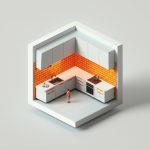Ever wondered about the real difference between a floor plan and a blueprint? While both illustrate building designs, their purposes and levels of detail differ significantly. This guide simplifies these essential documents, ensuring you can confidently discuss your project with architects and contractors, whether it’s a bathroom remodel or new commercial construction. We’ll explore their unique characteristics, explain how to read them, and help you determine the right plans for your specific needs. For a deeper dive into floor plans, check out this helpful resource: learn more.
Floor Plan vs. Blueprint: Decoding Construction and Design Documents
Floor plans and blueprints are essential in architecture and construction, but they serve distinct roles. A floor plan offers a simplified overview of a building’s layout, focusing on spatial relationships and intended use. A blueprint, or a complete set of construction documents, provides comprehensive technical instructions necessary for construction.
Think of a floor plan as a visual guide that displays the arrangement of rooms, walls, and doorways. A blueprint, however, is a detailed manual that specifies every aspect of the building, from structural components to electrical wiring. A floor plan helps determine where things should be, while a blueprint dictates how to build them correctly and safely.
The Floor Plan: A Bird’s-Eye View of Your Space and Intended Use
A floor plan is a two-dimensional representation of a building’s layout, viewed from above. It emphasizes room arrangements, dimensions, and basic features such as doors, windows, and major appliances. A floor plan provides a general sense of space, facilitating visualization and planning for furniture placement and room function.
Consider redesigning a living room. A floor plan displays the dimensions and arrangement of furniture, allowing homeowners to evaluate traffic flow and functionality. It’s a starting point for ensuring everything fits comfortably and the space meets its intended function.
The Blueprint: The Builder’s Comprehensive Guide
A blueprint, or a comprehensive set of construction plans, includes detailed technical drawings essential for building a structure. These drawings encompass structural, plumbing, electrical, and HVAC (heating, ventilation, and air conditioning) systems. Blueprints offer precise details and instructions for builders to correctly complete a project.
Want the exact dimensions of the foundation’s footings or the precise location of every electrical outlet? Structural and electrical blueprints provide this information. Blueprints offer contractors detailed specifications to build according to the design and comply with building codes. They are vital for obtaining permits and ensuring the building’s structural integrity and safety.
Choosing the Right Plans for Your Project
The type of drawing needed depends on the scope and complexity of your project:
- Simple Painting Project: Broad measurements and a general color schematic are usually sufficient.
- Minor Bathroom Update: A detailed floor plan may suffice. However, electrical and plumbing specifics are necessary if moving fixtures.
- Major Kitchen Renovation: A detailed floor plan is essential, along with plumbing and electrical blueprints.
- Building a New House: A complete set of blueprints is required, including structural, electrical, plumbing, HVAC, and landscaping plans.
- Commercial Development: Expect an extensive blueprint set, including specialized drawings for fire safety, accessibility compliance, and environmental impact.
According to the U.S. Census Bureau, over 1.4 million new housing units were authorized by building permits in 2024, reflecting the ubiquitous need for accurate blueprints in construction.
The Impact of Digital Design and Virtual Reality
Computer-aided design (CAD) software has revolutionized the design process, allowing detailed floor plans to evolve into comprehensive sets of construction documents. Building Information Modeling (BIM) goes a step further, creating a digital representation of the physical and functional characteristics of a building. Virtual Reality (VR) takes digital design to the next level by immersing clients in a 3D model of their future space. This transition improves communication and understanding throughout the design and construction phases.
Navigating Terminology and Avoiding Ambiguity
The term “blueprint” is often used loosely to describe any technical drawing, which can cause confusion. Historically, it referred to drawings made using a cyanotype process, resulting in blue lines on white paper.
Addressing this ambiguity through clear communication—between homeowners, designers, contractors, and inspectors—is crucial for avoiding misunderstandings. Using specific terminology like “construction documents” or “architectural plans” helps ensure everyone is on the same page.
Understanding the differences between floor plans and blueprints is essential for successful project planning. Choosing the correct plan ensures clear communication and accurate project execution.
How to Choose Between Floor Plans and Blueprints for Home Remodeling
Choosing the right architectural document is vital for any successful home remodeling project. Understanding whether you need a floor plan or a blueprint helps save time, money, and potential project delays. The collaborative effort between different design disciplines ensures effective project delivery.
Key Takeaways:
- Floor plans show room arrangements, while blueprints detail construction specifics.
- The choice depends on the project scope and your role in the remodeling process.
- Homeowners and designers may need floor plans for visualization, while contractors need blueprints for accurate construction.
Understanding the Fundamentals of Architectural Documents
In home remodeling, the terms “floor plan” and “blueprint” are frequently used, yet their meanings differ significantly. A floor plan is a simplified view of your space, showcasing room layouts and sizes, best for homeowners to visualize changes.
In contrast, a blueprint is a detailed technical document with precise specifications for construction, including structural details, electrical wiring, plumbing, and HVAC systems. It’s the builder’s guide, ensuring correct project execution and compliance with building codes.
How to Choose: A Decision-Making Approach
Choosing between a floor plan and a blueprint relies on your role in the project and needs:
- Homeowners (Initial Stages): Primarily need floor plans to visualize the remodeled space and make informed decisions about layout and functionality.
- Architects & Designers: Create both. Start with floor plans for client approval, then develop detailed blueprints for construction.
- Contractors & Builders: Require detailed, accurate blueprints to fully understand the scope of work, ensuring correct and code-compliant construction.
According to a 2023 survey by Houzz, 60% of homeowners planned to remodel or redecorate, highlighting the importance of understanding these documents.
Navigating the Digital Age of Design
The digital transition has revolutionized the creation and sharing of floor plans and blueprints. Computer-Aided Design (CAD) software and 3D modeling programs offer enhanced accuracy, collaboration, and visualization. 3D floor plans improve the client experience, making spatial relationships easier to understand.
Potential Pitfalls and How to Avoid Them With Effective Planning
Misunderstandings often arise from unclear communication about architectural documents, leading to delays, budget overruns, and construction errors. Clear communication is vital. Ensure everyone uses the same, up-to-date plans, and utilize a decision tree to guide the process.
A Simple Analogy of Architectural Designs
Imagine assembling furniture. The floor plan is a simple diagram showing the furniture in a room, while the blueprint includes precise measurements for each piece, the material type, hardware, and assembly instructions.
Understanding Architectural Drawings for Simple Home Renovations
When undertaking home renovations, understanding the different types of architectural drawings is crucial. Knowing the difference between a simple floor plan and a detailed plan increases the odds of your project running smoothly and helps you communicate effectively with contractors and designers.
Key Takeaways:
- Floor plans offer a simplified overview, focusing on spatial arrangement.
- Blueprints are comprehensive technical documents guiding construction.
- For simple renovations, a detailed floor plan is usually sufficient.
What’s the Difference? Floor Plans vs. Blueprints
Floor plans and blueprints serve distinct purposes, with the former guiding you through spatial relationships and the latter serving as a construction manual.
A floor plan provides a simplified, top-down view showing room sizes, wall placement, and major fixtures. It’s primarily for visualization and space planning, helping you understand the flow of the house.
Blueprints are much more detailed, guiding the entire construction process with dimensions, material specifications, electrical layouts, and plumbing plans.
Navigating Simple Home Renovations
For minor projects like repainting or replacing kitchen cabinets, a full blueprint set isn’t needed; a detailed floor plan usually suffices. However, larger projects like extensions or altering load-bearing walls require comprehensive blueprints to ensure everyone shares the same vision.
Consider a bathroom remodel: a good floor plan visualizes the new layout, while blueprints give the contractor exact measurements for tiling, pipe routing, and electrical work.
Demystifying the Language of Drawings
Understanding basic elements like symbols and scales is vital, even for simple renovations. Many online resources offer tutorials on reading architectural plans, helping you communicate your needs effectively.
Collaborating Effectively with Contractors and Designers
Clear communication is key when working with architects, designers, or contractors. Ensure everyone references the correct drawings. Discrepancies can lead to costly mistakes. Don’t hesitate to ask questions, even if they seem basic, to avoid potential problems.
According to the National Association of Home Builders, remodeling projects increased by 12% in 2024, emphasizing understanding architectural drawings’ importance.
Interpreting Detailed Blueprints for Complex Commercial Projects
Commercial construction projects require meticulous planning and execution, making detailed blueprints invaluable. Interpreting these technical documents is essential for project managers, contractors, and specialized engineers to ensure code compliance and efficient project delivery.
Key Takeaways:
- Blueprints for commercial projects are highly detailed and specialized.
- Understanding structural, electrical, and HVAC systems is crucial.
- Collaboration and communication among stakeholders are paramount.
The
- Modern Kitchen Backsplash Ideas To Inspire Your Refresh - December 19, 2025
- Modern Backsplash Ideas: A Guide to Todays Kitchen Trends - December 18, 2025
- Ceramic Kitchen Wall Tiles: Style and Protection for Your Walls - December 17, 2025









